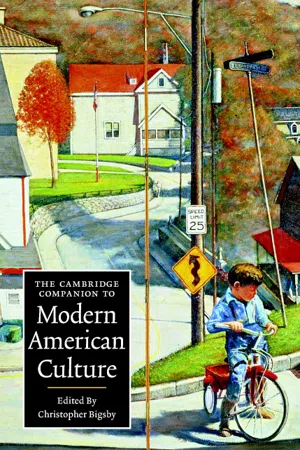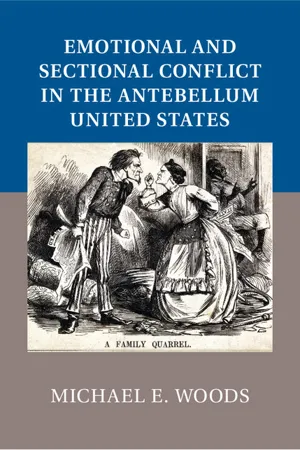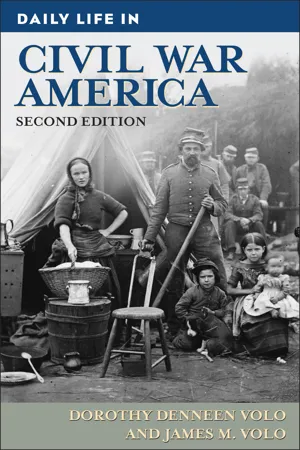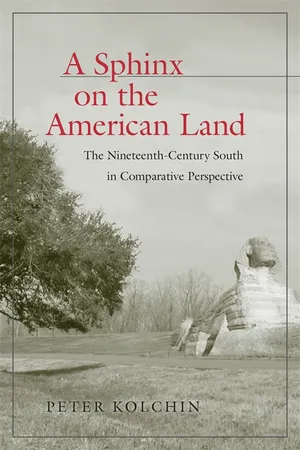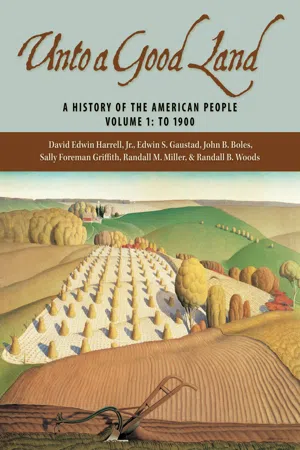History
Sectionalism in the Civil War
Sectionalism in the Civil War refers to the deep-rooted differences between the Northern and Southern states of the United States. These differences were primarily based on economic, social, and political factors, including slavery. The sectionalism ultimately led to the secession of Southern states and the outbreak of the Civil War.
Written by Perlego with AI-assistance
Related key terms
1 of 5
7 Key excerpts on "Sectionalism in the Civil War"
- Christopher Bigsby(Author)
- 2006(Publication Date)
- Cambridge University Press(Publisher)
3 R I C H A R D H . K I N G The regions and regionalism US history has been profoundly shaped by the existence of regions and regional consciousness, though the terms “sections” and “sectionalism” were more commonly used until the late nineteenth century. In its formative moments – the Continental Congress and the Constitutional Convention – the new republic was already divided along sectional lines that in turn marked out different economic, social, political, and security interests. Indeed, two of the defining “facts” about the United States of America – the existence of slavery and the presence of (so-called) “free land” in the West – made sectional politics inevitable. From them emerged the North–South and the East–West polarities in American politics and culture. Moreover, the three-sided contest among the Northeast, the South, and the West was one of the preconditions for the American Civil War (1861–5), with the South squared off against the North for control of the trans-Mississippi West. Without slavery there would have been no war, but had the peculiar institution been scattered evenly across the continent, it is hard to imagine that there could have been a sectional crisis. Several other factors have worked to make regions crucially important in the history of the United States. First, that the United States was a federal republic was of great, if ambiguous, importance. On the one hand, the federal structure of the United States and the strong (largely southern) sense that the United States was a compact among states rather than a contract among individuals encouraged hostility to federal interference in the affairs of the separate states. Still, a growing consciousness that common interests united the slave states and the desire to create a free state majority by excluding slavery from the West clearly challenged individual state sovereignty as much as did the exercise of federal power.- Michael E. Woods(Author)
- 2014(Publication Date)
- Cambridge University Press(Publisher)
As an act of organized violence, war requires both a willingness to kill and at least two reasonably united collectivities to engage in battle. Broadly shared emotional norms and publicly articulated emotional experiences culti- vated powerful feelings of sectional solidarity that steeled self-identified North- erners and Southerners to wage the nineteenth century’s second-largest war. Intensely personal and yet inevitably influenced by pervasive cultural norms, emotions shaped how participants perceived the politics of slavery and encour- aged budding sectionalists to align with one of the increasingly hostile sectional coalitions. The boundaries between “North” and “South” were never imper- meable, but emotional discourses and lived emotional experiences fostered the sectionalization of Americans’ political allegiances. This study also addresses why sectionalists marched to war in 1861. As Eugene Genovese observed, “Not every material interest is worth defending to the death, and it is not obvious that any should be.” 3 The same is true of social status, ideological devotion, or any of the other interests at stake in the Civil War. Because antebellum Americans scrutinized their feelings when confronted with weighty decisions, understanding how they interpreted specific emotions casts light on why war made sense to so many decent people. For nineteenth- century Americans, certain emotions were intimately tied to moral judgment. The prevalence of these emotions – including indignation and jealousy – in antebellum political discourse suggests that emotional responses to political events primed Americans to think in uncompromising terms of good versus evil. 2 Edward L. Ayers, “What We Talk About When We Talk About the South,” in Ayers, What Caused the Civil War? Reflections on the South and Southern History (New York: W.W. Norton & Company, 2005), 52.- eBook - ePub
Rethinking the Civil War Era
Directions for Research
- Paul D. Escott(Author)
- 2018(Publication Date)
- The University Press of Kentucky(Publisher)
18The fact that regional differences are relevant to these questions should alert us to another large area that is fertile ground for new research. We are accustomed to talking about the South as a whole and about a binary conflict between the North and the South. But new work has shown us the value of treating the slaveholding states as well as the free states in a more differentiated manner. William Freehling probably deserves the credit for first bringing this theme strongly to our attention. In his important work, he not only divides the South or identifies its regions in a different way but also documents how important those regional differences proved to be during secession and in the Civil War. Others have now taken the insight even further.19New work goes beyond a recognition that some leading politicians in the border region between the North and the South opposed aggressive pro-slavery measures, such as the Lecompton Constitution, and considered making a political alliance with conservative Republicans. This work calls for a new way of looking at the border region in the sectional clash. The dynamics of sectionalism played out differently along the border than they did in either the South or the North. We can conceive of this middle, border region as consisting of an upper or border South and a lower North. Its northern portions barred slavery but contained many residents with Southern ties or sympathies. The slaveholding elements of this border area were economically and culturally different from the Deep South and its black belts. Political and cultural values, for example, among slaveholders in Kentucky or Missouri were similar both to those of “Unionist Whigs in North Carolina, Tennessee, and Virginia” and to those of “conservative Democrats in Illinois, Indiana, and Ohio.” Such similarities between this border South and lower North could even be seen as far west as Iowa.20 - eBook - PDF
- Dorothy Volo, James M. Volo(Authors)
- 2009(Publication Date)
- Greenwood(Publisher)
This research has made it clear that secession, and not slavery, was the precipitating controversy of the war. Although anti-slavery was a promi- 6 Daily Life in Civil War America nent reform movement of the period, other causes, such as temperance, women’s rights, religious revival, public education, concerns for the poor, and prison reform, were as zealously pursued by activists. Of these, only slavery and disunion became politically charged issues in the antebel- lum period, and as the middle ground of compromise on such issues was eroded, only the extreme positions became viable, until disunion brought on armed conflict. Universal abolition, never an overall war aim of the Northern war effort, was not even recognized by the proclamation of emancipation of 1863. As expressed by one abolitionist, the prominence of secession as a cause of the war becomes obvious: “Who cares now about slavery. Secession, and the Oligarchy built upon it, have crowded it out.” 6 A Federal officer serving in the field noted, “The nearer [the men] ap- proach death the stronger is their hatred of Secession & the dearer is the sight of the true flag.” 7 The case for secession had flourished for more than seven decades, and it would seem, from an unbiased reading of the record, that the secession- ists had at least an arguable case on their side. By comparison, the case for a perpetual union was a recent product of the sectional conflicts of the 1850s. Moreover, its fundamental legal principles were far from perfect, and the logic behind its arguments was fraught with ambiguity. Unfor- tunately, the specific legal status of secession was never adjudicated by a The Hard Hand of War: Sketch artist Henry Lovie’s view of the condition of refugee families driven from their homes in the border states, as printed in Leslie’s Illus- trated Magazine. The Historian’s War 7 court due to the haste with which both North and South resorted to armed conflict. - eBook - PDF
A Sphinx on the American Land
The Nineteenth-Century South in Comparative Perspective
- Peter Kolchin(Author)
- 2003(Publication Date)
- LSU Press(Publisher)
A n earlier version of this thesis is evident in David Donald, “ A n Ex cess of Democracy: The A merican Civil War and the Social P rocess,” in his L inc ol n R ec o nsi d ere d: E ssays o n t h e C ivi l W ar E ra , 2 d ed. (New York: Vintage Books, 1961 ), 209 – 36 . the south and the un -south 21 ers had the attitudes and goals . . . of ca p italistic businessmen,” he argued that “the South’s p olitical system . . . like its hierarchical so-cial structure, conformed closely to the p revailing arrangements in the North.” Concluding that “the antebellum North and South were far more alike than the conventional scholarly wisdom has led us to believe,” P essen suggested that their coming to blows “may have been due, as is often the case when great p owers fight, as much to their similarities as to their differences.” But writing three years later, James M. Mc P herson reached a diametrically o pp osite conclu-sion. “ A ntebellum A mericans certainly thought that North and South had evolved se p arate societies,” he noted, “with institutions, interests, values, and ideologies so incom p atible, so much in deadly conflict that they could no longer live together in the same nation.” P ointing to contrasts in “urbanization, industrialization, labor force, demogra p hic structure, violence and martial values, educa-tion, and attitudes toward change,” he suggested that contem p orary p erce p tions of difference were largely accurate. 19 A t the heart of this controversy is the question of to what e x tent slavery set the antebellum South off from the rest of the country. Here, too, longstanding disagreements remain unbridged. To over-sim p lify a com p le x and highly charged debate, one can divide histo-rians of the slave South into two broad categories. O n the one side are those such as Stanley L. E ngerman, R obert W. Fogel, and James O akes, who stress the p rofit-orientation of slaveholders and p ortray southern slavery as p reeminently ca p italistic. - eBook - ePub
Unto a Good Land
A History of the American People, Volume 1: To 1900
- David Edwin Harrell, Edwin S. Gaustad, John B. Boles, Sally Foreman Griffith(Authors)
- 2005(Publication Date)
- Eerdmans(Publisher)
14
Sectionalism and Slavery’s Dark Cloud: The Coming of the Civil War, 1846-1861
Chapter 14 at a Glance Confronting “the Slave Power” Slavery in the Territories From the California Gold Rush to the Uneasy Compromise of 1850 Uncle Tom’s Cabin The Collapse of the Whig Party The Storm over Fugitive Slaves Douglas’s Kansas-Nebraska Bill The Party System in Flux Anti-Catholicism and the Know-Nothings The Rise of the Republican Party The Road to Civil War Bleeding Kansas The Ominous Election of 1856 The Dred Scott Decision National Divisions Widen Lincoln and Douglas Debate John Brown’s Raid The Fateful Election of 1860 Lincoln and the Secession Crisis Conclusion: Outbreak of War at Fort SumterS ELDOM DO HISTORICAL actors fully understand the long-range consequences of events in which they participate. But in 1846 two thoughtful observers of the national scene, one southern, the other northern, had a fateful premonition of the repercussions that would result from the war in Mexico. In South Carolina, John C. Calhoun had opposed action against Mexico in part because he anticipated that war would increase the size, authority, and expense of the national government, all of which he interpreted as working against the interests of the South. More important, Calhoun feared that northern opposition to the war would escalate to the point of threatening the Union. Meanwhile, a thousand miles away in Massachusetts, Ralph Waldo Emerson confided to his diary at the beginning of the war that “the United States will conquer Mexico, but it will be as the man who swallows the arsenic, which brings him down in return. Mexico will poison us.”These eerily accurate predictions grew out of understandings of how deeply entrenched were the fundamental divisions that existed in the nation, divisions that the political parties had tried to paper over or ignore. But in the aftermath of the Mexican War these divisions became no longer vague abstractions but practical problems that demanded policy decisions. Politicians and political parties had to come up with answers, and the attempt to solve the problem led to the famous Compromise of 1850, which a generation of hopeful Americans wanted to believe had settled the disruptive issues for good. Yet events soon proved the compromisers wrong and the pessimists like Calhoun and Emerson right. Slavery — the question of whether it was right or wrong, the question of whether it should be confined to the South or allowed to spread, the question of whether it should be abolished everywhere — raised questions so momentous that it ultimately became impossible to sustain a compromise. The result was the poison Emerson had feared: Disunion. - eBook - PDF
Secession as an International Phenomenon
From America's Civil War to Contemporary Separatist Movements
- Don Doyle(Author)
- 2010(Publication Date)
- University of Georgia Press(Publisher)
This stemmed, according to most versions of the story, from the early migration pattern in the American colonies. Whereas the Cavaliers of the English Civil War had settled in the South, their Roundhead enemies had settled in the North. Over the years, these ethnic differences had survived, festered, and ulti-mately produced secession and Civil War—the inevitable result of a fundamental ethnic difference between northerners and southerners. Here was an attempt, at least, to fit the southern cause into the mold of European ethnic nationalism. Another ethnic-style basis for southern nationalism derived from the central foundation of the whole enterprise, racial slavery. As they sought to convince fellow southerners of the benefits of leaving the Union, secessionists sometimes cast North-South difference in racial terms. Accusing northerners, and espe-cially the “Black Republican Party,” of advocating racial equality, white south-erners contrasted the North’s supposed racial “amalgamation” with their own dedication to racial purity and the unalloyed supremacy of the white race. After secession, this line of thinking received its most well-known expression from Alexander Stephens, vice president of the Confederate States. In his famous [ 164 ] Paul Quigley “cornerstone” speech of March 1861, Stephens posited “African slavery” as the “immediate cause” of secession. Unlike the United States, which held a mis-guided belief in “the equality of the races,” the Confederacy recognized the di-vine truth of racial in equality. Indeed, Stephens said, the Confederacy’s “foun-dations were laid, its cornerstone rests, upon the great truth that the negro is not equal to the white man; that slavery, subordination to the superior race, is his natural and moral condition.” Herein, for Stephens, lay the essence of the Confederacy’s claim to a distinct national identity.
Index pages curate the most relevant extracts from our library of academic textbooks. They’ve been created using an in-house natural language model (NLM), each adding context and meaning to key research topics.
